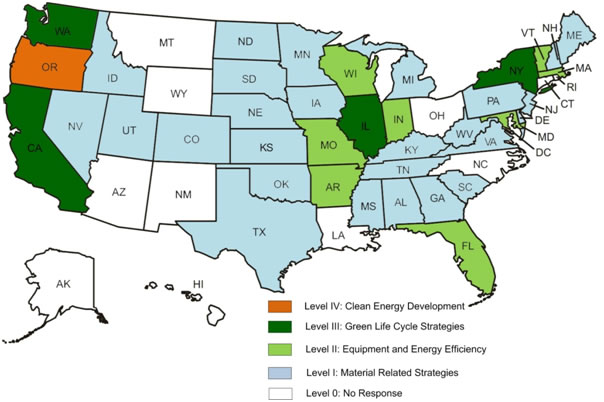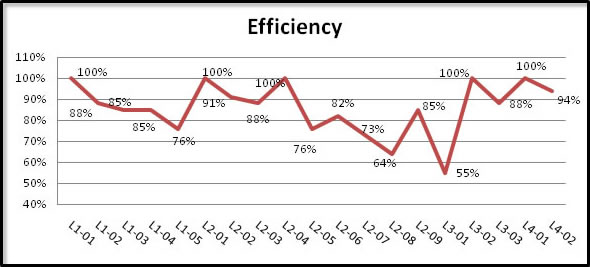INNOVATIVE CONTRACTING STRATEGIES FOR COMBATING CLIMATE CHANGE
Please Refer to the Full Report
INTRODUCTION
With the growing public awareness of climate change and the need to take action against it, an increasing number of state highway agencies have started to integrate climate change considerations into transportation system development and operations. While many studies over the past decade have been done regarding emission reduction and adaptation strategies for traffic operations, very few have dealt with these challenges in the highway project development and delivery process. More focus should be on the process and delivery of green contracting practices used to reduce emissions from highway construction activities. Instead of just focusing on the product, emissions need to be considered and regulated throughout the entire project lifecycle, including the planning and development phases of highway projects.
WHAT IS GREEN PERFORMANCE CONTRACTING (GPC)?
We define green contracting as contract provisions, contracting methods, and delivery strategies that help reduce emissions and improve adaptation to climate change. A broader definition covers sustainability’s economic, environmental, and social aspects. Discussed more in depth in the full report are 19 available green contracting strategies used in highway development and construction. Based on the simplicity and widespread use of the strategies, we have classified these 19 strategies into four levels:
Level I - Material Related Strategies (the most common methods utilized)
Level II – Equipment and Energy Efficiency Strategies
Level III – Green Life Cycle Strategies
Level IV – Clean Energy Development
Level |
Strategy |
I |
L1-01 Reclaimed Asphalt Pavement (RAP) |
L1-02 Other Material Recycling or Reusing |
L1-03 Sustainable Material Treatment |
L1-04 Material Waste Management |
L1-05 Material Life-Cycle Management |
II |
L2-01 Equipment Retrofit Technology |
L2-02 Engine Repower and Upgrade |
L2-03 Idling Reduction |
L2-04 Alternative Fuels |
L2-05 LED Lighting |
L2-06 Equipment Operation and Maintenance Management |
L2-07 Equipment Selection and Vehicle Electrification |
L2-08 Work Zone Traffic Management |
L2-09 Employee Commuting Reduction |
III |
L3-01 Green Road Rating System |
L3-02 Climate Impact Analyses |
L3-03 Climate Adaptation Design |
IV |
L4-01 Highway-related Solar Energy |
L4-02 Highway-related Wind Turbine |
Green contracting strategies can be incorporated into various-sized projects and different project delivery systems, and state highway agencies have various levels of experience in applying the four levels of green contracting strategies to highway projects. A survey was sent out to all state Departments of Transportation (DOT) and the results are shown in the following Figure.

EFFICIENCY EVALUATION
Before implementing a strategy, the agency must be knowledgeable about state and federal standards and laws associated with the strategy, as well as contract specifications and provisions from federal organizations such as EPA or FHWA. The agency should also consider possible risks and benefits that may take place as a result of applying the strategy. These considerations are discussed in greater detail in the GPC strategy cards.
After becoming familiar with the GPC cards, the agency may score each strategy based on seven criteria:
Financial Consideration,
Technological Maturity,
Organizational Readiness,
Industrial and Public Acceptance,
Emission Reduction,
Impact on Project Performance,
Risks.
In order to assess the efficiency of each strategy, an optimization model: Data Envelopment Analysis (DEA) can be applied in order to measure and calculate the performance efficiency of each strategy. Sample results are shown in the Figure below:

RECOMMENDATIONS
To integrate these strategies, transportation agencies are recommended to create agency-wide initiatives to promote green practices at the project level. The successful implementation of sustainable practices requires strong organizational support and collaboration from other areas beyond contracting and construction administration. In addition, it is critical that the implementation of green contracting strategies involves widespread industry support for results-oriented strategies over those that are predominantly cost-driven.
An integrated framework for environmental performance contracting should be formulated from state goals and modeled after the successful practices of other agencies. Green contracting strategies should be integrated into highway development, design, and construction guidelines. The state highway agency needs to work with the construction industry to establish terminology and guidelines for green contracting. It is important that the Maryland SHA continues to pursue the integration of sustainable practices into transportation construction and operations by establishing green contracting guidelines and continuing sustainability research and development.